
|
A RUSH TO JUDGEMENT: Chapter 8 |

|
|---|
Who Were The Players?
WHO FRAMED VICTOR LICATA – Who Were The Players?
If Victor Licata did not commit the murders; If he (as we presume in this book) was framed? Then this begs the obvious question – WHO DID? And even more important, Why?
Because the case is so far removed in time (almost a hundred years at this point), solid answers to the above questions are (at this point), all but impossible. However, by looking over the evidence, we are still (at least) able to do a bit of speculation on the matter. Here in this chapter, we begin by looking over some of the major players; those with good reason to have their hands involved in the matter. Those who would have wanted the Licata’s dead and why they did? And after that (in subsequent chapters): -- Why these same individuals would want to frame Victor for the crime? What would their motivation be for doing such a thing?
HOWEVER, in addressing these questions, one is quickly struck in awe (in fact almost all-struck in awe), by the sheer number of high-stake players, whose names came up. Which of and by itself creates a bit of a mystery. As one would assume that Victor Licata, being a simple boy and given his mental state, (we assume below average intelligence etc.), would have no enemies at all.
Yet, SOMEHOW, SOMEWAY, it seems that this simple kid figured out a way to get (figuratively speaking), half the world out to get him. So much so that one almost starts to get cynically facetious about this matter. With Victor, it seems that it wasn’t a matter of who wanted to do it; ---It was more of a matter of who didn’t. Exactly how one autistic kid (19 or 20 years of age) could have pissed off so many high-level people is beyond anyone’s imagination, yet somehow, he did.
8.1 – THE PLAYERS
Here (ignoring all the little fish that may also have been out to get him -- of which given Victor's charm and skills he probably had plenty of), let’s just look at a (very partial) list of some of the major players.
WARNING: The reader should take heed -- MOST of the following is SPECULATION, but the stated facts are real. For example, did the fascist dictator Benito Mussolini really order the killings? Probably not, but neither can we ignore the fact that there was a physical connection linking the two individuals.
In the next chapter, we begin to go over the evidence against Victor. Each piece of evidence will be examined on an individual basis.
8.2 – Benito Mussolini
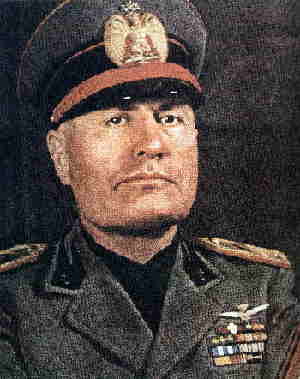
No, this is not Harry Anslinger dressed up in drag, but instead a picture of Benito Mussolini the head of the fascist government of Italy at the time
Quoting Inside Detective Magazine (July 1938):
“I was moving towards the telephone. Rex Farrier followed me closely. “You know the family,” he was saying. “Phillip Licata, the Italian consul, is a brother of Mike (Victor Licata’s father) who was killed here. There might be a lead even in these names, for prominent people often make enemies.”That the Licata family was involved in/with the Italian government of Benito Mussolini is also confirmed as per the Tampa Morning Tribune Oct 18, 1933 p1 :
“The family was well known in Italian circles here and had resided in Tampa for 40 years. Michael Licata, the father, was a brother of Philip F. Licata, Italian consul here;”One supposes that one could always theorize some sort of Italian Government (Benito Mussolini was in charge of Italian Government at that time) involvement, with either pro or anti-fascist elements involved. But it should be noted that as far as we have been able to tell, no such conspiracy existed. However, like everything else, this is not to say that it didn’t. Here it is mentioned solely as just one more possibility to keep in the back of one's mind.
MUSEUM NOTE: All our efforts to contact the Italian Embassy so far have met with no replies. Boy, those guys just don’t like us, or are still under orders to cover this whole thing up.
8.3 – THE KU KLUX KLAN, - THE BLACK LEGION,
AND THE TAMPA POLICE DEPARTMENT
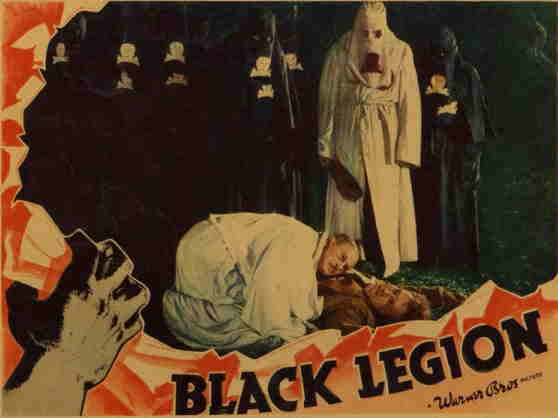
The Black Legion
Just how much influence did the TRIPLE "K" have within the Tampa police department? By all accounts, “Quite-Ah-Lot.” Perhaps the Joseph Shoemaker affair serves as a good example of exactly just how much.
In November of 1935 (just two years after the Licata Murders), members of the Tampa Police Department (without an arrest warrant) broke into a home where a group known as the Modern Democrats were holding a meeting. Three members were taken to jail, where they were interrogated about their Communist activities and then turned over to a mob of individuals (who just happened to have been there). The mob kidnapped them (right in front of the police station) and took them to the woods where all three were flogged, beaten, tarred and feathered etc.According to one website:
Two of them made it back to Tampa, but Joseph shoemaker wasn’t so lucky, he died of his wounds, BUT NOT BEFORE identifying those who had done it – which included members of the Tampa Police department.
Now, up to this point, the Roosevelt administration, which needed the support of the Dixiecrats for their agenda, had been looking the other way when it came to the activities of the Klan as well as the Black Legion. [8A] The Joseph Shoemaker affair (and a few others) finally forced Roosevelt to take a stand. That and the publicity forced Florida officials to bring indictments against five (former as well as present) Tampa police officers [C.A. Brown, John P. Bridges, C.W. Carlisle, Sam E. Crosby, F.W. Switzer, and Robert L. Chappell], AS WELL AS IT’S Chief of Police R. G. Tittsworth. It should also be noted that two witnesses, Police Sergeant Carl Tompkins (who jumped out of a window), and Robert P. Fariss (who was found dead in his automobile) both were said to have committed suicide.
“To the indictment of five police officers and the chief, all accused of being loyal to the Ku Klux Klan and inciting the mob. Five of the officers were sentenced to four years in prison for kidnapping. But the sentences were overturned by Florida's Supreme Court.”In other words, they got away with it – that was how strong the Klan was back then.
Where does Victor fit into all of this? – Well Victor (while he was white) was not an Anglo, he was not Protestant, was a moonshine whiskey runner, and . . and. . as we shall see in subsequent sections, JUST DIDN'T FIT IN with the Klan’s version of things. AND worst of all, was from a prominent family.
8.4 – PHILIP F. LICATA
– ITALIAN COUNSEL GENERAL (Tampa Area)
It is a fact that Philip Licata, Mike Licata’s (Victor’s father) brother was the Italian government's counsel general for the Tampa Area. Which in turn means that he may have made a lot of enemies. Enemies that (due to his status) may not have been able to strike out at him directly, BUT maybe indirectly through his brother (Victor's father).
A good example of this can be found in the March 17, 1933 p1, issue of the “St. Petersburg Times” newspaper; “Bronson Jury Convicts Two Cedar Key Men”
This was the case in which two White Protestant Individuals (one of them a former Justice of the Peace) were convicted of murdering 3 Greek fisherman. Pretty bloody affair from what we can tell. The two using their badge of authority arrested the three fishermen, . . (two of the prisoners had their skulls crushed in by a blunt axe like object, and the third showed stab wounds.), . . all three Greek fishermen were taken to a wooden jail (which somehow caught on fire) . . . killing all three . . etc.The problem is that there was a White Protestant Girl involved in the situation, . . . which explains how the KKK could have become involved etc. . .
Anyway, this caused quite a stir among the non Anglo Protestant Individuals in the area, etc. And because the 3 Greeks had Italian citizenship . . etc. . . Philip Licata acting as counsel general . . . entered the picture . . etc.
Also note the date of the article; this happened just 6 months before the Licata murders occurred.
PLEASE NOTE -- The TRIPLE "k’s" involvement is shear speculation, but the above example shows the kind of dealings that Philip Licata (as Benito Mussolini’s Tampa representative), had in the area. Who knows if he ran afoul of the K.K.K. or not, or of Mussolini’s own government, or of the Italian Mafia, or . . . etc.
8.5 – J. REX FARRIOR – State ATTORNEY
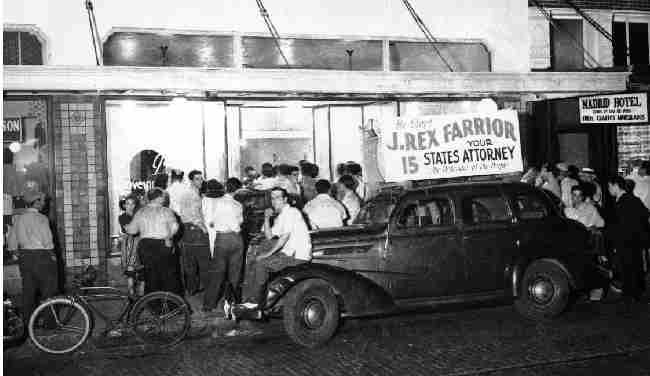
Political rally for J. Rex Farrior [8C]
Courtesy of the Tampa Historical Society
Without proof, there is no question in the author’s mind that Farrior was NOT the most forthcoming man, when it came to the Licata murder case. He just had to know more about the matter. The problem is that it will take a whole book (devoted solely to this guy), just to try to figure out what he did or did not know.
Historically speaking (from a modern-day standpoint), this guy can be seen as either Hero or Villain depending upon the time frame. On one hand he became involved in anti-Klan activities and in the other he stood by and did nothing as Victor Licata was being framed. You figure?
In a magazine article (of questionable historical reliability), entitled "Marihuana Maniac" (July 1938 Inside Detective Magazine), by Tampa police chief detective W.D. Bush, Mr. Farrier becomes one of the main characters:
“Found something?” I turned and faced J. Rex Farrier, the state’s attorney. "I hurried over,” he explained, "to see if I could help. Tried to have a talk with that young fellow Victor, but his mind is unhinged. The shock has been too great."Farrior (who was still district attorney up until the 1940’s) must have known/read the story and must have known that it was a work of fiction passing itself off as the truth. Yet to our knowledge, he remained quiet as a mouse on the subject. In addition (as per chapter 3 of this book), there was the Earl Rowell factor. As per his book, “On the Trail of Marihuana, the Weed of Madness”:
I tapped the pocket where I had put the reefers. "A marihuana addict did this," I said. "He washed up in here [in the bath room] and smoked a few reefers.” "There may be an addict among their friends,” said Farrier quickly. . . . I was moving towards the telephone. Rex Farrier followed me closely. “You know the family,” he was saying. “Phillip Licata, the Italian consul, is a brother of Mike who was killed here. There might be a lead even in these names, for prominent people often make enemies.” . . . .
While other men worked on this, Farrier and I went through the house of death again. I reconstructed for him my theory again. I reconstructed for him my theory of how the crime was committed. . . . “He lost no blood on the floor. There are dog hairs in those stains on the carpet and dog hairs in the stains through the hall to the front door.” “You haven’t found the animal?” inquired Rex Farrier.
. . . . The telephone was ringing as the District Attorney and I followed the dog’s trail to the front door. . . It was with a lighter heart that I joined Rex Farrier on the front porch. . . .
The District Attorney nodded. Then he assumed a listening attitude. “There’s a sound,” he said, “coming from under this porch. I’ve heard it a couple of times while you were telephoning. Sounds like something or somebody stirring around.” [more -- dealing with when they found the dog ]
“On our tour of the states we arrived in Tampa a few months after this horrible crime took place. The police and district attorneys' staff who worked on the case told us the entire terrible and fantastic story, and took us to the house where the crime had been enacted.Note, that again Farrior (or at least his staff) was involved. Also note that (to our knowledge) no attempt was ever made to correct. In fact, throughout the whole of the Reefer Madness Era, J. Rex Farrior made absolutely no attempts to correct any of the statements made on the matter during the Reefer Madness Era. (see Chapter 2) Nowhere did he write even so much as a letter to a magazine or newspaper to make corrections. Thus, without question, Farrior was involved, if not directly in the murders themselves, then certainly in the cover up that followed.
The police confided to us also that the father, who had been murdered, was by no means blameless, for he had been making these cigarettes and having his son Victor peddle them to the students at the high school he attended. In time, Victor sampled his own product. Then came the quintuple murder. Thus, the father, who had sown the wind, reaped the whirlwind.”
Lastly (from the newspaper articles that we have been able to locate about him), he seemed to like grand-standing; holding press conferences, being the center of attention, etc. Which of and by itself is nothing wrong, but (psychologically speaking) making it hard for a person of that mental state to go around retracting things. For him to have simply gotten up in public and just have stated, "Hey people, I was wrong" didn't seem to have been in his nature.
In addition, according to an article written by Michael Mundt, “The Ku Klux Klan’s 1926 Assault on the Democratic party in Hillsborough County.” Either by happenstance or by design, Farrior found himself running against a slate of Klan candidates in that election (many of which won). Thus, he was at least familiar with the power that the Klan had at the voting booths, a power that he would, in all probability, not want to run afoul of.
8.6 – EARLE ROWELL
-- On the Trail of Marihuana; The Weed of Madness
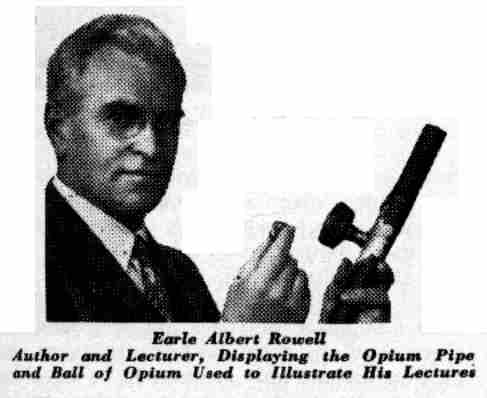
As stated in chapter 3, we have not been able to find strong biological ties between him and the Rowell family murders (1926). Murders committed by (what we believe to be) the same axe murderer that murdered the Licata’s in 1933. However, it simply seems too coincidental that he would show up on the scene just a few months after the Licata murders.
Also, from a psychological viewpoint, --Given Mr. Rowell’s views about other forms of drug addicts (that they should be given maintenance), it is hard to understand his views --- as written in his book, “On the Trail of Marihuana, the Weed of Madness,” on Marihuana in any other way.
Also, were he not directly involved [see chapter 3]; Why would the police, the district attorney's office, etc., have given Mr. Rowell (who was not even a Florida resident) a guided tour of a crime scene? Or confide in him and give him so much (probably false) information about Victor, etc?
However, it must be noted, that there is no evidence that he had anything to do with the murders, nor (given the nature of the man), do we believe that he had any direct doing in the framing of Victor Licata.
However, he might have been used (probably was) as a tool by the narcs to disseminate false information about the nature of the killings. Putting the Blame on Marihuana and on Victor instead of searching for the real killers.
8.7 – FRANK S. CASTOR
- State Drug and Narcotic Inspector
Conspiracy, laziness, incompetence, whatever it was that happened, this guy is obviously up to his neck in it. No question about it; he was one of the conspirators.
According to the Tampa Morning Tribune Oct 18, 1933 p1 “Crazed Youth Kills Five of Family with Ax in Tampa Home”
“Had Smoked Marijuana W.D. Bush, city detective chief, said he had made an investigation prior to the crime and learned the slayer had been addicted to smoking marijuana cigarettes for more than six months. This he said, had unbalanced his mind, at least temporarily.Note however, that in another version of the story by W.D. Bush (found in the July 1938 issue of "Inside Detective")
A similar statement was made by Frank S. Castor; state drug and narcotic inspector, who said he had aided Bush in the investigation, and was prepared to make charges against the youth when he heard of the ax slayings. He had also learned of several places where Licata bought the doped cigarettes. “
[first and foremost off all] “Get the marihuana fiends.” And then I (Bush) added, “Telephone Frank Caston and get the files of all the cases on which he and I worked a couple of months ago. Work with Frank in the roundup of addicts.”Chief Detective Bush then goes on to tell about how he interrogated a Marihuana Fiend in jail and that that was how he discovered that Victor was a Medical Marihuana addict. NOT via the investigation as stated in the newspaper article above. In addition, in the 1933 (actually 1934) "Annual report - State Board of Health, State of Florida" Frank S. Castor writes as follows:
Frank S. Caston being a drug and narcotic inspector for the state of Florida. Only a month before the bloody day in the Licata house, Frank and I had made a sortie into the realms of the reefers, confiscating supplies of the drug, placing the pitiful victims of its craving in institutions. Our investigations had revealed much that could be of value now. “
"Annual report - State Board of Health, State of Florida"That’s it, that’s all. No actual mention of the Licata case, nothing. Obviously, someone is trying to ignore the whole thing at this point.
Frank S. Castor; state drug and narcotic inspector,
DRUG INSPECTION
The work of the Division of Drug Inspection has continued to the satisfaction of all but a few of the pharmacists of the state and has been instrumental in maintaining pharmaceutical practices on a high plane, the work has been greatly increased by new duties in the enforcement of the Uniform Narcotic Drug Act (Laws of 1933). The work of the drug inspectors has revealed a serious smuggling of marihuana cigarettes, which is one of the worst of the narcotic evils. The marathon dance halls have been found to be favored hangouts for criminals engaged in marihuana smuggling. A few unprincipled physicians have been indicted for trafficking in narcotics, such as opium, cocaine, etc. In order to check the evils of narcotic addiction an increased inspection force will be needed. The inspectors could also assist in gathering information on violators of medical practice and other healing arts, e.g. dentistry, embalming, etc. “
8.8 – Dr. H. MASON SMITH - Psychiatrist

Dr. H. MASON SMITH - Pahokee, Florida (1928)
Courtesy - State Library & Archives of Florida
Dr. H. Mason Smith, the main psychiatrist on whose word Victor Licata was deemed insane, (thus not able to stand trial), had on the surface (and probably in real life), spotless and quite impressive medical credentials.
At the time he was highly experienced, with many years of experience as a psychiatrist and at one time was even the head of the State Hospital in Chatahoochee; --the one to which Victor was now being sent to. Leaving the post only due to America’s entry into the first World War and it’s need for Military doctors.*
With the sole exception that one of his patients (Leonard Skeggs of Youngstown Ohio) shot and killed himself in his office just five months prior to the Licata incident (this was on April 30, 1933) we’ve found nothing wrong with him.
* This part of the story varies a bit, but we believe it to be the most accurate one.
8.9 – THE LYNCH MOB

TampaTribune1933-10-18 p1
According to a newspaper account:
Tampa Morning Tribune Oct 18, 1933 p1Which seems very reminiscent of what happened back in 1927 with the Benjamin Levins affair.
Crazed Youth Kills Five of Family with Ax in Tampa Home
“. . . a crowd had gathered at the little bungalow, and as the police car sped away, there were shouts from the crowd of “get him:---kill him.”
And while no one can accuse a mob of people (who obviously) just started to gather at the scene, of participating in a conspiracy against Victor, still, remembering the Benjamin Levins affair (see chapter 7), it seems that we also can’t overlook this as a factor. Did someone? Could someone, have organized the crowd into being?
8.10 – THE ITALIAN MAFIA
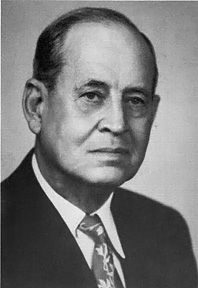 Charlie Wall Head Tampa Mafioso at the time |
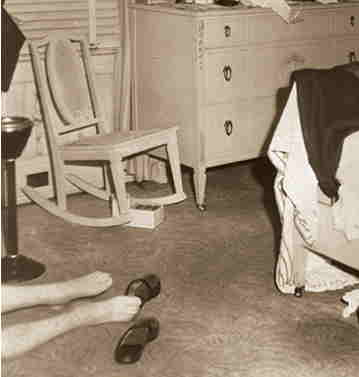 Charlie's Death (crime scene photo) Note how similarly his death was to that of Mike Licata |
LICATA, we have been told is a major town of some kind in the middle of Sicily – which in turn is the home of the Italian Mafia or criminal network. And yes, it is a fact that the Licata family did originally come from Italy etc. And yes, some major mob figures did carry the last name of Licata. ----- Is this to say that ALL Italian-Americans (whose last names happen to be Licata), are members of the Mafia? Obviously not, only an idiot would think that. However, here we are not talking about generalities but instead about the facts involved in this one particular case.
According to Earle Rowell:
“The police confided to us also that the father, who had been murdered, was by no means blameless, for he had been making these cigarettes and having his son Victor peddle them to the students at the high school he attended. In time, Victor sampled his own product. Then came the quintuple murder. Thus the father, who had sown the wind, reaped the whirlwind.”In other words, the Tampa cops were saying that something illegal was happening at the time. Even Victor Licata stated as much:
Victor, by his own story, returned to his father’s home sometime between 8 and 10 o’clock Monday night. His father was at his barbershop. His mother was working in the kitchen. Providence, his sister, was out. Fourteen-year-old Phillip and eight-year-old Jose were in bed. Victor himself, if he followed his customary habits was “charged to the skies” on marijuana, sodden in moonshine liquor. For hours before he went home, he rode on somebody’s truck---a liquor truck, he said---but he refused to name his companions. -- Tampa Times - Oct 18, 1933 p1 *NOTE: In 1933 Alcohol Prohibition was still the law of the land in Florida. Thus, Victor's activities must have been (A) Organized and (B) Illegal. AKA Mafia stuff, and Mike Licata must have known (and approved of) what his son was doing. He probably thought of it as a way of keeping the boy off the streets and doing something-useful, etc.
But (maybe, possibly, could have), something went wrong. According to the Newspaper Reports:
“That the family feared for their lives was declared by relatives. The father, they said, habitually slept with a pistol between his mattress.” --- Tampa Times Oct. 17, 1933 p1*And even Victor had tried to obtain a weapon for defense.
“Last night, it was said, Victor attempted unsuccessfully to borrow a pistol from a neighbor. “ --- Tampa Times Oct. 17, 1933 p1And granted, while the newspaper accounts made it sound as if Victor himself was the object of fear in the Licata Family. WHAT IF the object of fear, was actually the Mafia. Wouldn’t that change everything? What if BOTH Victor and his father had wanted weapons for self-defense against a very possible “Saint Valentine's Day” style massacre?
According to one website: [8D]
CRIME AND POWER* WARNING – Much of the quoted information, has already been shown to have been incredibly inaccurate, if not out and out dis-information. Probably part of a cover up.
Indeed, the 1920s and '30s were among Tampa's darkest years, when organized crime brought the city national attention and disdain. For gambling. For bootlegging. And for so many gangland slayings from 1928 to 1959 that Tampa earned the moniker "Little Chicago."
And who was Tampa's crime czar? A descendant of two of the town's best-known pioneer families - Charlie Wall, related to both the Lykes and McKay clans. He was the kingpin in the bolita racket, a lottery game imported by Cuban immigrants.
Wall turned the game into a massive enterprise involving the city's powerful and elite in payoffs and political corruption that extended throughout Tampa's law enforcement community. Numbers games flourished, as did prostitution and smuggling - indeed, historians say Prohibition made Tampa, with its access to the bay, a bootlegger's paradise.
8.11 – HARRY ANSLINGER (America’s First Drug Czar):
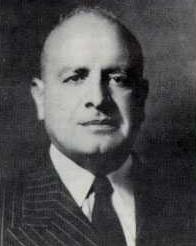
Harry Anslinger
Originator of the Anti-Medical Marihuana Laws
NO ONE that we know of is accusing Harry Anslinger (our nation's first drug czar) of any direct involvement in the Licata Family murders. However, once they had occurred, he most assuredly took a hand in the cover-up conspiracy that followed and may have even been the one to order the deaths of both Victor Licata as well as his own ghost writer Courtney Ryley Cooper as part of that cover up.
8.12 – Courtney Ryley Cooper
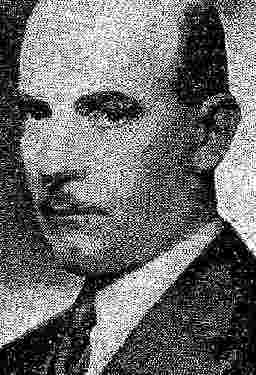
Courtney Ryley Cooper
Although having no direct link to the Licata murders, still circumstances would come together to link him in to the conspiracy, AND may have even led to his own (either murder or suicide) death in 1940.
His Florida home in Sebring, being less then 100 miles away from the Murder scene in Tampa would mean that most assuredly he would have been aware of the murders. However, as Harry Anslinger's Ghost writer, it was he who most assuredly wrote the following [The American Magazine July 1937]:
Marijuana the Assassin of YouthStatements that may have led to his own death only 3 years later.
“It was an unprovoked crime some years ago which brought the first realization that the age-old drug had gained a foothold in America. An entire family was murdered by a youthful addict in Florida. When officers arrived at the home, they found the youth staggering about in a human, slaughterhouse. With an ax he had killed his father, his mother, two brothers, and a sister. He seemed to be in a daze.
“I’ve had a terrible dream,” he said. “People tried to hack off my arms!”
“Who were they?” an officer asked.
“I don’t know. Maybe one was my uncle. They slashed me with knives and I saw blood dripping from an ax.”
He had no recollection of having committed the multiple crime. The officers knew him ordinarily as a sane, rather quiet young man; now he was pitifully crazed. They sought the reason. The boy said he had been in the habit of smoking something which youthful friends called “muggles,” a childish name for marijuana . . . “
8.13 – THE DOG
Almost all the information given about the dog (who plays such an important role in Victor’s arrest) comes from the Detective (July 1938) story. However, according to friends and relatives of the Licata family, the Licata’s DID NOT HAVE A DOG. In addition (see Chapter 9) the storie's author has been shown to be (how shall we put it), while a spinner of a good story, less than accurate in the factual department. So, no one knows where the dog, nor this fake photo of him came from.

According to Chief Detective W.D. Bush:
“The young German shepherd dog made no sound. It rose on stiffened legs, and then crouched again, every hair along its neck and back rising in a ridge of hackles. The dog’s black-tipped nose was pointed straight at the opening door. As the murderous invader entered, the dog leaped for his throat.
But the intruder was ready. He swung the blade to meet the dog’s attack. The axe missed the animal’s head and drove deep through the bones and tendons of one shoulder. The brave beast fell back, blood spurting from its side. The murderer’s foot swung out and hurled the dog a full five feet across the floor. . . . [more]
. . . . The dog, one shoulder terribly mutilated half dead from the blood-loss, followed the murderer’s trail to the sidewalk. Crawling and pulling itself along, the courageous brute followed for a dozen yards and there collapsed. A few minutes later the dog revived sufficiently to retrace its course and crawl beneath the front porch to lick the aching wound.
Like a phantom the slayer had come into the sleeping house at 1707 Fifth Avenue in Tampa, Florida. And like a bloody ghoul he had gone, leaving behind five mutilated human beings and a brave dog that still whimpered beneath the porch.
“We broke the front door to get in,” said Stewart quickly as I glanced at the shattered glass. “But the back was open.”
“And yet the killer passed out this way,” I said, staring at that trail of Blood upon the hall floor.
“The dog,” corrected Stewart. “The family dog has disappeared. There’s dog hair in that blood trail. . . .[more]
. . . “The dog,” he said. “It’s the dog, bleeding and in terrible shape.” We coaxed the animal out. It dragged itself painfully and slowly towards the policeman’s outstretched hand. It was a half-grown German shepherd. In its right shoulder was a raw rent that laid open skin and flesh until the shattered bone was visible.
The dog allowed itself to be lifted in gentle hands. “Get it to a veterinarian,” I told the policeman. Then as a sudden thought occurred I added, “Get him to do everything in his power to keep that dog alive. Tell him we want that dog---living and active again.” The policeman looked at me wonderingly for a moment, then grinned a wide Irish smile. “I get it,” he said. “This dog’ll know that killer.” . . .
. . . We took him (Victor) to the veterinarian’s hospital, and there a strange scene was enacted.
Victor Licata stood in the center of the veterinarian’s office. An attendant was sent for the wounded dog. The young man watched the door through which the dog would enter, and I saw his eyes narrow. The muscles in his sallow jaws worked convulsively. He seemed to brace himself for what he knew was coming.
Under the ministrations of the veterinarian the dog was able to limp along on three legs, the fourth being supported by splints and bandages on the injured shoulder. The animal paused in the doorway. . . Then slowly it crouched, its eyes fixed on the face of the marihuana fiend.
Before the attendant could tighten his grip on the leash, the dog had sprung. In spite of its injury, forcing itself into the air with a lunge of his powerful flanks, the German shepherd leaped straight for Victor Licata.
We dragged the dog away, growling and fighting, its mouth frothing and its head turned always towards the trembling youth.
“Your father owned that dog for almost a year,” I told Victor when we were back at the jail again. “The dog grew up from a puppy with you always around the house. It must have known you---been friendly with you---until you turned its friendship to hatred with that axe.”
8.14 – Detective Chief W.D. Bush (Tampa, Florida)
As Chief Detective (Tampa Police Department) on the case, he automatically comes into prominence as one of the main players. However, he comes into even more prominence because of an article “Marihuana Maniac!” [Inside Detective July 1938] about the Licata case, in which he (as chief detective in the case) plays the leading role.
NOTE: this article (as fictitious as it is), is one of the few eye witness accounts that we have on the case. Thus whatever conspiracy took place, he would have had to have had his hand in it.
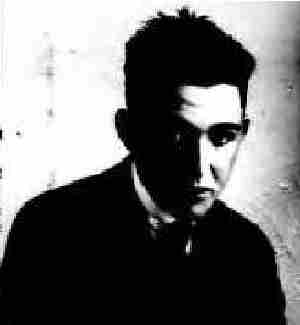 As per Passport application (1921) |
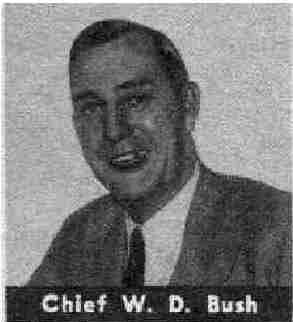 As per Inside Detective magazine (1938) |
MUSEUM NOTE: We have not been able to locate any close relationship to either president that bore the same last name.
[SEE CHAPTER 9, FOR MORE ON W.D. BUSH AND THE INSIDE DETECTIVE ARTICLE]
8.15 – THE ACTUAL ASSASSIN

THE UNKNOWN ASSASSIN(s)
The one person(s) that are usually left out of the equation is the actual assassin(s) --- Those who actually committed the crime. Toward the end of this book, we do some speculation on the matter, but without some major breakthrough, all that can be written on the matter is pure speculation.
===========
FOOTNOTES:
[8A]-- According to the Wikipedia “The Black Legion was an organization that splintered from the Ku Klux Klan and operated in the United States in the 1930s” So thus technically there is a distinction between the two, however for the sake of simplicity, here in this book we treat both groups as being one and the same.
http://en.wikipedia.org/wiki/Black_Legion_%28political_movement%29
[8B]-- http://www.tampabay.com/google_archive/search.php
[8C]-- Try as we might this was the only picture we have been able to find of him
[8D]-- http://www.urbanplanet.org/forums/index.php/topic/4713-our-beginnings-a-story-about-tampas-history/
VICTOR LICATA - A RUSH TO JUDGEMENT
WANT TO KNOW MORE:
=====================
Due to space / download time considerations, only selected materials are displayed. If you would like to obtain more information, feel free to contact the museum. All our material is available (at cost) on CD-Rom format. Please contact: antique_andy@catholic.org
 Back to Chapter 7 |
 VICTOR LICATA MAIN INDEX |
 On to Chapter 9 |